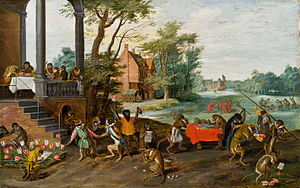Allegory of the Tulipomania

|
| Allegory of the Tulipomania |
|---|
| Jan Brueghel the Younger , 1640s |
| Oil on wood (parquet) |
| 30 × 47.5 cm |
Allegory of Tulipomania is a satirical painting by Jan Brueghel the Younger from the 1640s. The subject of the oil painting on wood is the tulip mania in the Netherlands in the 17th century. The dimensions are 30 × 47.5 cm. It was auctioned at the Im Kinsky auction house in 2011 and is privately owned. A similar version belongs to the collection of the Frans Hals Museum in Haarlem .
The paintings
Structure and technology
The foreground and middle distance are dominated by humanized monkeys, only three real people can be seen in front of the house in the middle distance. The left quarter of the picture almost entirely takes up the vaulted porch of a palace-like building. A stream or river runs diagonally past the house and a group of trees to a lake with a moated castle. Behind and on the right bank is forest.
It is an oil painting on wood ( parquet ). The foreground is kept in dark, earthy tones, the middle ground in yellow and green tones and the distance in blue tones. The painter thus intensifies the impression of spatial depth.
Interpretation and history
In the Renaissance, monkeys were regarded as a satirical symbolization of human greed and stupidity. The subject of the picture is the tulip mania that was rampant in the Netherlands in the 1630s. An ape society dines under a vaulted porch, a “merchant” in a green doublet is just starting a new business, a monkey dressed in orange and yellow has invested all of his fortune in a tulip and an accountant monkey weighs tulip bulbs with gold. A group of red-clad speculators gathers in the middle distance, to the right of it, disappointed buyers are fighting (fencing). In the right foreground, a monkey who has speculated on his money is being led to the judge and right in front of it another is urinating on the most expensive variety of tulips. This is perhaps the illustration of a Dutch proverb about the illusion of achieving the impossible.
The picture had been in a private collection in Austria since the 1920s. In 2011 it was attributed to Jan Brueghel the Younger and auctioned off at the Im Kinsky auction house in Vienna. The reviewer was Klaus Ertz . The starting price was 25,000 euros , the hammer price of 74,000 euros (with a premium of 92,500) was won by a French telephone bidder.
Other versions
There are two other versions, one of which is a satire op de Tulpomania ( satire on tulpomania) in the Frans Hals Museum in Haarlem, the Netherlands.
Historical background
The tulipomania , also called tulip madness, tulip fever or tulip hysteria, was a brief period in the Dutch Golden Age , when tulip bulbs became an object of speculation. At the height of the tulip madness around 1633 three rare tulip bulbs in Hoorn reached the equivalent of a house, in 1637 there was a rapid fall in prices with significant financial losses for the speculators. The tulip mania is seen as the first speculative bubble in economic history. The most valuable type of tulip was the Semper Augustus , which was traded in early 1637 for a price of 10,000 guilders. Breughel's picture is richly endowed with this variety of tulips.
Individual evidence
- ↑ a b Im Kinsky - 87th art auction on November 8, 2011 ( Memento from January 26, 2013 in the web archive archive.today ) accessed on January 21, 2012
- ↑ Olga Kronsteiner: Historically documented stupidity , (accessed on January 21, 2012) DER STANDARD / ALBUM - print edition, 22./23. October 2011
- ↑ Olga Kronsteiner: Brueghel's Affenzirkus in Vienna (handelsblatt.com, November 16, 2011, 5:52 p.m.) accessed on January 21, 2012
- ↑ Geheugen van Nederland: Satire op de Tulpomania, accessed on August 16, 2013
- ^ Plant hunt ( Memento from May 5, 2013 in the Internet Archive )




